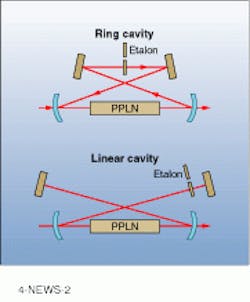High-power singly resonant OPO operates CW

A high-power, CW-output, singly resonant optical parametric oscillator (OPO) based on periodically poled lithium niobate (PPLN) has been demonstrated by a team of researchers from Lightwave Electronics Inc. (Mountain View, CA) and Stanford University (Stanford, CA). With 13.5 W of pump power at 1.064 µm, the OPO achieved 3.5 W at 3.3 µm--equivalent to about 80% of the quantum-limited performance. The wavelength of the OPO was tunable, resulting in more than 1 W of CW output from 3.3 to 3.9 µm.
Singly resonant OPOs--in which only the signal wave is resonated in the cavity--offer better amplitude and spectral stability compared to doubly resonant devices, which resonate both the signal and idler waves. The oscillation threshold of singly resonant OPOs is, however, more than 100 times higher than for the doubly resonant configuration. Until recently, only pulsed pump lasers have been able to achieve the intensity required to drive a singly resonant OPO--preferred because of its better stability--while CW devices have been limited to doubly resonant configurations with their inherent instabilities.
The advent of PPLN, with its high gain and low loss, has made possible CW oscillation thresholds of only a few watts when the OPO is pumped at 1.064 µm by a Nd:YAG laser. In this case, the output of a prototype single-transverse-mode, multiple-axial-mode, diode-pumped Nd:YAG laser based on Lightwave`s direct-coupled-pump technology was used to pump the OPO. The pump-laser output is nearly diffraction limited (M2~1.1) and has a linewidth of about 2.2 GHz; the beam is mode-matched to the OPO cavity.
Two cavity configurations were characterized by the researchers. One was a four-mirror ring cavity, the other a four-mirror linear cavity (see figure). Both configurations used the same 50-mm-long PPLN crystal. According to Lightwave`s Walt Bosenberg, the two cavity configurations exhibited similar conversion characteristics although their respective spectral characteristics were different.
The ring-cavity OPO consistently operated on a single axial mode (linewidth less than 0.02 cm-1) of the OPO resonator with mode hops occurring about every 30 seconds. The linear-cavity OPO, however, tended to run with linewidths of about 2 cm-1, corresponding to about 220 axial modes. An uncoated etalon in both cavities allowed nearly continuous wavelength tuning with no reduction in output power.
With this technology, says Bosenberg, output wavelengths between 1.35 and 4.2 µm should be available using properly configured crystals and optics.
Singly resonant continuous-wave optical parametric oscillator based on periodically poled lithium niobate (PPLN) was characterized using a four-mirror ring cavity (upper) and a four-mirror linear cavity (lower). Both cavities exhibited similar conversion characteristics but their spectral properties were different.
Stephen G. Anderson | Director, Industry Development - SPIE
Stephen Anderson is a photonics industry expert with an international background and has been actively involved with lasers and photonics for more than 30 years. As Director, Industry Development at SPIE – The international society for optics and photonics – he is responsible for tracking the photonics industry markets and technology to help define long-term strategy, while also facilitating development of SPIE’s industry activities. Before joining SPIE, Anderson was Associate Publisher and Editor in Chief of Laser Focus World and chaired the Lasers & Photonics Marketplace Seminar. Anderson also co-founded the BioOptics World brand. Anderson holds a chemistry degree from the University of York and an Executive MBA from Golden Gate University.